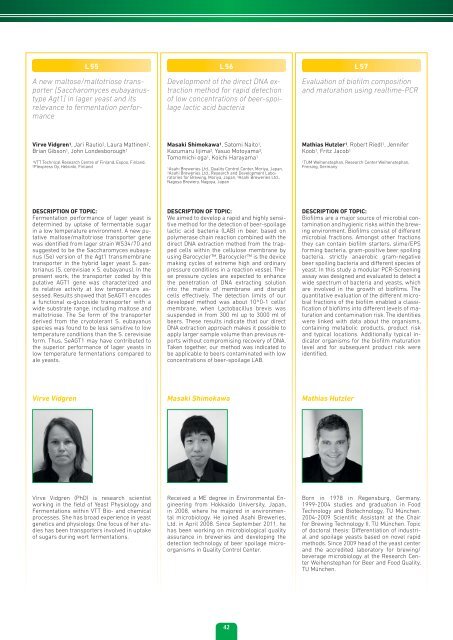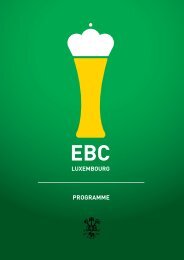please click here for download. - the 34th European Brewery ...
please click here for download. - the 34th European Brewery ...
please click here for download. - the 34th European Brewery ...
You also want an ePaper? Increase the reach of your titles
YUMPU automatically turns print PDFs into web optimized ePapers that Google loves.
L 55<br />
A new maltose/maltotriose transporter<br />
[Saccharomyces eubayanustype<br />
Agt1] in lager yeast and its<br />
relevance to fermentation per<strong>for</strong>mance<br />
Virve Vidgren 1, Jari Rautio 2, Laura Mattinen 2,<br />
Brian Gibson 1, John Londesborough 1<br />
1VTT Technical Research Centre of Finland, Espoo, Finland,<br />
2Plexpress Oy, Helsinki, Finland<br />
DESCRIPTION OF TOPIC:<br />
Fermentation per<strong>for</strong>mance of lager yeast is<br />
determined by uptake of fermentable sugar<br />
in a low temperature environment. A new putative<br />
maltose/maltotriose transporter gene<br />
was identifi ed from lager strain WS34/70 and<br />
suggested to be <strong>the</strong> Saccharomyces eubayanus<br />
(Se) version of <strong>the</strong> Agt1 transmembrane<br />
transporter in <strong>the</strong> hybrid lager yeast S. pastorianus<br />
(S. cerevisiae x S. eubayanus). In <strong>the</strong><br />
present work, <strong>the</strong> transporter coded by this<br />
putative AGT1 gene was characterized and<br />
its relative activity at low temperature assessed.<br />
Results showed that SeAGT1 encodes<br />
a functional α-glucoside transporter with a<br />
wide substrate range, including maltose and<br />
maltotriose. The Se <strong>for</strong>m of <strong>the</strong> transporter<br />
derived from <strong>the</strong> cryotolerant S. eubayanus<br />
species was found to be less sensitive to low<br />
temperature conditions than <strong>the</strong> S. cerevisiae<br />
<strong>for</strong>m. Thus, SeAGT1 may have contributed to<br />
<strong>the</strong> superior per<strong>for</strong>mance of lager yeasts in<br />
low temperature fermentations compared to<br />
ale yeasts.<br />
Virve Vidgren<br />
Virve Vidgren (PhD) is research scientist<br />
working in <strong>the</strong> fi eld of Yeast Physiology and<br />
Fermentations within VTT Bio- and chemical<br />
processes. She has broad experience in yeast<br />
genetics and physiology. One focus of her studies<br />
has been transporters involved in uptake<br />
of sugars during wort fermentations.<br />
L 56<br />
Development of <strong>the</strong> direct DNA extraction<br />
method <strong>for</strong> rapid detection<br />
of low concentrations of beer-spoilage<br />
lactic acid bacteria<br />
Masaki Shimokawa 1, Satomi Naito 1,<br />
Kazumaru Iijima 2, Yasuo Motoyama 3,<br />
Tomomichi oga 1, Koichi Harayama 1<br />
1Asahi Breweries Ltd., Quality Control Center, Moriya, Japan,<br />
2Asahi Breweries Ltd., Research and Development Laboratories<br />
<strong>for</strong> Brewing, Moriya, Japan, 3Asahi Breweries Ltd.,<br />
Nagoya <strong>Brewery</strong>, Nagoya, Japan<br />
DESCRIPTION OF TOPIC:<br />
We aimed to develop a rapid and highly sensitive<br />
method <strong>for</strong> <strong>the</strong> detection of beer-spoilage<br />
lactic acid bacteria (LAB) in beer, based on<br />
polymerase chain reaction combined with <strong>the</strong><br />
direct DNA extraction method from <strong>the</strong> trapped<br />
cells within <strong>the</strong> cellulose membrane by<br />
using Barocycler. Barocycler is <strong>the</strong> device<br />
making cycles of extreme high and ordinary<br />
pressure conditions in a reaction vessel. These<br />
pressure cycles are expected to enhance<br />
<strong>the</strong> penetration of DNA extracting solution<br />
into <strong>the</strong> matrix of membrane and disrupt<br />
cells eff ectively. The detection limits of our<br />
developed method was about 10^0-1 cells/<br />
membrane, when Lactobacillus brevis was<br />
suspended in from 300 ml up to 3000 ml of<br />
beers. These results indicate that our direct<br />
DNA extraction approach makes it possible to<br />
apply larger sample volume than previous reports<br />
without compromising recovery of DNA.<br />
Taken toge<strong>the</strong>r, our method was indicated to<br />
be applicable to beers contaminated with low<br />
concentrations of beer-spoilage LAB.<br />
Masaki Shimokawa<br />
Received a ME degree in Environmental Engineering<br />
from Hokkaido University, Japan,<br />
in 2008, w<strong>here</strong> he majored in environmental<br />
microbiology. He joined Asahi Breweries,<br />
Ltd. in April 2008. Since September 2011, he<br />
has been working on microbiological quality<br />
assurance in breweries and developing <strong>the</strong><br />
detection technology of beer spoilage microorganisms<br />
in Quality Control Center.<br />
42<br />
L 57<br />
Evaluation of biofi lm composition<br />
and maturation using realtime-PCR<br />
Mathias Hutzler 1, Robert Riedl 1, Jennifer<br />
Koob 1, Fritz Jacob 1<br />
1TUM Weihenstephan, Research Center Weihenstephan,<br />
Freising, Germany<br />
DESCRIPTION OF TOPIC:<br />
Biofi lms are a major source of microbial contamination<br />
and hygienic risks within <strong>the</strong> brewing<br />
environment. Biofi lms consist of diff erent<br />
microbial fractions. Amongst o<strong>the</strong>r fractions<br />
<strong>the</strong>y can contain biofi lm starters, slime/EPS<br />
<strong>for</strong>ming bacteria, gram-positive beer spoiling<br />
bacteria, strictly anaerobic gram-negative<br />
beer spoiling bacteria and diff erent species of<br />
yeast. In this study a modular PCR-Screening<br />
assay was designed and evaluated to detect a<br />
wide spectrum of bacteria and yeasts, which<br />
are involved in <strong>the</strong> growth of biofi lms. The<br />
quantitative evaluation of <strong>the</strong> diff erent microbial<br />
fractions of <strong>the</strong> biofi lm enabled a classifi<br />
cation of biofi lms into diff erent levels of maturation<br />
and contamination risk. The identities<br />
were linked with data about <strong>the</strong> organisms,<br />
containing metabolic products, product risk<br />
and typical locations. Additionally typical indicator<br />
organisms <strong>for</strong> <strong>the</strong> biofi lm maturation<br />
level and <strong>for</strong> subsequent product risk were<br />
identifi ed.<br />
Mathias Hutzler<br />
Born in 1978 in Regensburg, Germany.<br />
1999-2004 studies and graduation in Food<br />
Technology and Biotechnology, TU München.<br />
2004-2009 Scientifi c Assistant at <strong>the</strong> Chair<br />
<strong>for</strong> Brewing Technology II, TU München. Topic<br />
of doctoral <strong>the</strong>sis: Diff erentiation of industrial<br />
and spoilage yeasts based on novel rapid<br />
methods. Since 2009 head of <strong>the</strong> yeast center<br />
and <strong>the</strong> accredited laboratory <strong>for</strong> brewing/<br />
beverage microbiology at <strong>the</strong> Research Center<br />
Weihenstephan <strong>for</strong> Beer and Food Quality,<br />
TU München.





